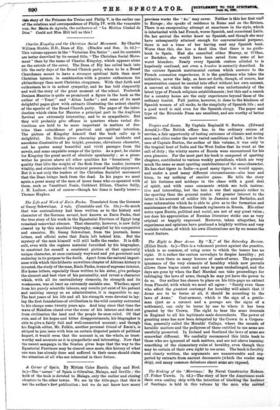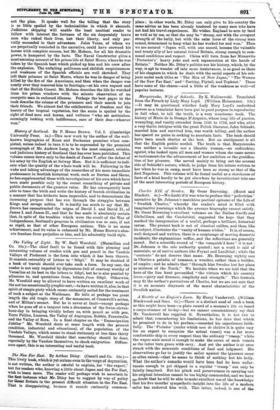The Sinking of the Merrimac.' By Naval Constructor Hobson. (T.
Fisher Unwin. 7s. 6d.)—The story of how the Americans sunk their own coaling ship with the intention of blocking the harbour of Santiago is told it this volume by the man who carried
out the plan. It speaks well for the telling that the story is so little spoiled by the technicalities in which it abounds. Judicious skipping will enable the least nautical reader to follow with interest the fortunes of the six desperately brave men who risked their lives, lost their liberty, and only par- tially succeeded in their adventure. Jules Verne, of whom we are perpetually reminded in the narrative, could have crowned his heroes with complete success, but Mr. Hobson, for all his dramatic power, is hampered by the facts. The Naval Constructor gives a mostamuein,g account of his prison life at Saint Morro, where he was taken by the Spanish boat which picked up him and his crew after the explosion. The unfailing politeness and childish suspiciousness and weakness of the Spanish officials are well sketched. They left their prisoner at Saint Morro, where he was in danger of being killed by the fire of the Americans, and then when the danger was nearly over they removed him to Santiago,—at his own request and that of the British Consul. Mr. Hobson describes the life he watched from his prison windows with the minute observation of an energetic man in enforced idleness. Perhaps the best pages in the book describe the release of the prisoners and their march to join their friends. We almost feel the exhilaration of freedom and the beauty of the tropical vegetation, but the scene is spoiled by the sight of dead men and horses, and vultures "who sat motionless, seemingly looking with indifference, sure of their due—whoever won."



















































 Previous page
Previous page